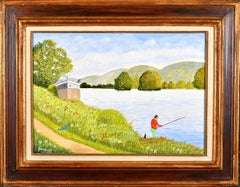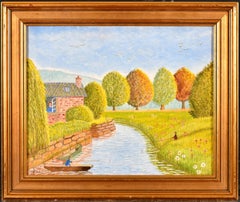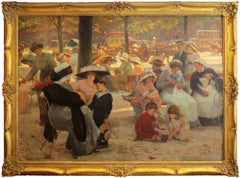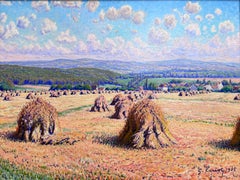André Bouquet. Paintings
to
2
2
2
1
1
Overall Height
to
Overall Width
to
2
1
1
1
1
1
2
2
863
659
652
610
2
2
1
1
Artist: André Bouquet.
Fisherman on a Riverbank - Mid 20th Century French Naif Landscape Oil Painting
By André Bouquet
Located in Sevenoaks, GB
A beautiful mid 20th century French naif oil on canvas depicting a man fishing on a riverbank by André Bouquet. The artist featured in Anatole Jakovsky's ''Peintres Naifs'' which is known as the bible of 20th century naif painters.
The work is signed lower left and presented in it's original painted and gilded reverse profile gallery frame.
Artist: André Bouquet (French, 1897-1987)
Title: Fisherman on a River Bank
Medium: Oil on canvas
Size: 19 x 24.5 inches (48 x 62 cm) including the frame
André Bouquet was a butcher by trade, who had his stall in open air markets. In order to have more time to paint, however, he became a factory cook and later a foreman in the same factory.
He lived only for his painting, which once he stopped working he did every day of the week, including Sundays. He is a sensitive and delicate artist, especially when depicting Parisian suburbs, of which he has caught the atmosphere remarkably. He also painted numerous snow landscapes.
Source: Anatole Jakovsky - Peintres Naifs - Paris 1956
Category
Mid-20th Century André Bouquet. Paintings
Materials
Oil
Fishermen on a River - Mid 20th Century French Naif Landscape Oil Painting
By André Bouquet
Located in Sevenoaks, GB
A beautiful mid 20th century French naif oil on canvas depicting two men fishing on a river by André Bouquet. The artist is featured in Anatole Jakovsky's ''Peintres Naifs'' which is known as the bible of 20th century naif painters.
The work is signed lower left and presented in it's original gallery frame.
Artist: André Bouquet (French, 1897-1987)
Title: Fishermen on a River
Medium: Oil on canvas
Size: 16.5 x 19.5 inches (42 x 50 cm) including the frame
André Bouquet was a butcher by trade, who had his stall in open air markets. In order to have more time to paint, however, he became a factory cook and later a foreman in the same factory.
He lived only for his painting, which once he stopped working he did every day of the week, including Sundays. He is a sensitive and delicate artist, especially when depicting Parisian suburbs, of which he has caught the atmosphere remarkably. He also painted numerous snow landscapes.
Source: Anatole Jakovsky - Peintres Naifs - Paris 1956
Category
Mid-20th Century André Bouquet. Paintings
Materials
Canvas, Oil
Related Items
"Sunday in the Park, 1910"
By Cyprien Eugène Boulet
Located in Lambertville, NJ
Signed Lower Right
Cyprien-Eugène Boulet (1877 - 1927)
Category
Early 20th Century Impressionist André Bouquet. Paintings
Materials
Canvas, Oil
Meules dans un Paysage Vallonné
Located in London, GB
Haystacks in a field in the summer sunshine.
As a youth, he dedicated his spare time to drawing and sketching various views of the city and countryside surrounding Paris. Largely ...
Category
20th Century André Bouquet. Paintings
Materials
Canvas, Oil
"Snow Squals, Parmelee Farm"
By Peter Poskas
Located in Lambertville, NJ
Signed Lower Left
Poskas was born in Waterbury, Connecticut, a small industrial city set on the banks of the Naugatuck River. He was interested in art as a child, but on entering ...
Category
20th Century American Realist André Bouquet. Paintings
Materials
Canvas, Oil
Strawberries Strewn on a Forest Floor
By William Mason Brown
Located in New York, NY
William Mason Brown was born in Troy, New York, where he studied for several years with local artists, including the leading portraitist there, Abel Buel Moore. In 1850, he moved to ...
Category
19th Century American Realist André Bouquet. Paintings
Materials
Canvas, Oil
The Harvest
Located in London, GB
Farmhands working in a field on a hot summer's day.
Building on iconic depictions of farmworkers by Millet, Huys sought to imbue his figures with a sensitivity and reverence that ...
Category
20th Century André Bouquet. Paintings
Materials
Canvas, Oil
'Agay, le château et le Sémaphore'. Oil on canvas. Signed.
By Armand Guillaumin
Located in Paris, FR
'Agay, le château et le Sémaphore'.
Oil on canvas. +/- 1922
Signed lower right
Measurements : 60 x 73 cm.
This painting will be recorded in the second volume of the Catalogue Raisonn...
Category
1920s Impressionist André Bouquet. Paintings
Materials
Oil
H 23.63 in W 28.75 in
San Pedro Harbor
By Paul Sample
Located in New York, NY
It is infrequent, to say the least, that a diagnosis of tuberculosis proves fortuitous, but that was the event, in 1921, that set Paul Starrett Sample on the road to becoming a professional artist. (The best source for an overview of Sample’s life and oeuvre remains Paul Sample: Painter of the American Scene, exhib. cat., [Hanover, New Hampshire: Hood Museum of Art, 1988] with a detailed and definitive chronology by Sample scholar, Paula F. Glick, and an essay by Robert L. McGrath. It is the source for this essay unless otherwise indicated.) Sample, born in Louisville, Kentucky, in 1896 to a construction engineer and his wife, spent his childhood moving with his family to the various locations that his father’s work took them. By 1911, the family had landed in Glencoe, Illinois, settling long enough for Paul to graduate from New Trier High School in 1916. Sample enrolled at Dartmouth College, in Hanover, New Hampshire, where his interests were anything but academic. His enthusiasms included the football and basketball teams, boxing, pledging at a fraternity, and learning to play the saxophone. After the United States entered World War I, Sample, to his family’s dismay, signed on for the Naval Reserve, leading directly to a hiatus from Dartmouth. In 1918 and 1919, Sample served in the U.S. Merchant Marine where he earned a third mate’s license and seriously contemplated life as a sailor. Acceding to parental pressure, he returned to Dartmouth, graduating in 1921. Sample’s undergraduate life revolved around sports and a jazz band he formed with his brother, Donald, two years younger and also a Dartmouth student. In November 1933, Sample summarized his life in a letter he wrote introducing himself to Frederick Newlin Price, founder of Ferargil Galleries, who would become his New York art dealer. The artist characterized his undergraduate years as spent “wasting my time intensively.” He told Price that that “I took an art appreciation course and slept thru it every day” (Ferargil Galleries Records, circa 1900–63, Archives of American Art, Smithsonian Institution, available on line).
In 1920, Donald Sample contracted tuberculosis. He went for treatment to the world-famous Trudeau Sanitorium at Saranac Lake, in New York State’s Adirondack Mountains for the prescribed regimen of rest, healthful food, and fresh air. Visiting his brother in 1921, Paul also contracted the disease. Tuberculosis is highly contagious, and had no certain cure before the development of streptomycin in 1946. Even for patients who appeared to have recovered, there was a significant rate of recurrence. Thus, in his letter to Price, Sample avoided the stigma conjured by naming the disease, but wrote “I had a relapse with a bad lung and spent the next four years hospitalized in Saranac Lake.” The stringent physical restrictions imposed by adherence to “the cure” required Sample to cultivate an alternate set of interests. He read voraciously and, at the suggestion of his physician, contacted the husband of a fellow patient for instruction in art. That artist, then living in Saranac, was Jonas Lie (1880–1940), a prominent Norwegian-American painter and an associate academician at the National Academy of Design. Lie had gained renown for his dramatic 1913 series of paintings documenting the construction of the Panama Canal (The Metropolitan Museum of Art, New York; United States Military Academy, West Point, New York). Primarily a landscape artist, Lie had a particular affinity for scenes with water. His paintings, impressionistic, atmospheric, and brushy, never strayed from a realistic rendering of his subject. Sample regarded Lie as a mentor and retained a lifelong reverence for his teacher. Sample’s early paintings very much reflect Lie’s influence.
`
In 1925, “cured,” Sample left Saranac Lake for what proved to be a brief stay in New York City, where his veteran’s benefits financed a commercial art course. The family, however, had moved to California, in the futile hope that the climate would benefit Donald. Sample joined them and after Donald’s death, remained in California, taking classes at the Otis Art Institute in Los Angeles. In Sample’s account to Price, “I couldn’t stomach the practice of painting a lot of High Sierras and desert flowers which seemed to be the only kind of pictures that were sold here so I got a job teaching drawing and painting at the art school of the University of Southern California.” Initially hired as a part-time instructor, Sample progressed to full-time status and ultimately, by the mid-1930s, to the post of Chairman of the Fine Art Department. Sample, however, did not want to wind up as a professor. “Teaching is all right in small doses,” he wrote, “but I have a horror of drifting into being a college professor and nothing more.” At the same time as he taught, Sample began to exhibit his work in a variety of venues at first locally, then nationally. Though he confessed himself “a terrible salesman,” and though occupied with continued learning and teaching, Sample was nonetheless, ambitious. In 1927, he wrote in his diary, “I am eventually going to be a painter and a damned good one. And what is more, I am going to make money at it” (as quoted by Glick, p. 15). In 1928, Sample felt sufficiently solvent to marry his long-time love, Sylvia Howland, who had also been a patient at Saranac Lake. The Howland family were rooted New Englanders and in summertime the Samples regularly traveled East for family reunion vacations.
While the 1930s brought serious hardship to many artists, for Paul Sample it was a decade of success. Buttressed by the financial safety net of his teacher’s salary, he painted realist depictions of the American scene. While his work addressed depression-era conditions with a sympathetic eye, Sample avoided the anger and tinge of bitterness that characterized much contemporary realist art. Beginning in 1930, Sample began to exhibit regularly in juried exhibitions at important national venues, garnering prizes along the way. In 1930, Inner Harbor won an honorable mention in the Annual Exhibition of the Art Institute of Chicago. That same year Sample was also represented in a show at the Albright-Knox Gallery in Buffalo and at the Biennial Exhibition of the Corcoran Gallery of Art, Washington, D.C. In 1931, Dairy Ranch won the second Hallgarten Prize at the Annual Exhibition of the National Academy of Design, in New York. Sample also made his first appearances at the Carnegie Institute, Pittsburgh, and The Pennsylvania Academy of the Fine Arts, Philadelphia. In 1936, Miner’s Resting won the Temple Gold Medal at the Pennsylvania Academy’s Annual Exhibition. Always interested in watercolor, in 1936, Sample began to send works on paper to exhibitions at the Whitney Museum, New York.
While participating in juried exhibitions, Sample also cultivated commercial possibilities. His first New York art dealer was the prestigious Macbeth Gallery in New York, which included his work in a November 1931 exhibition. In 1934, Sample joined the Ferargil Galleries in New York, after Fred Price arranged the sale of Sample’s Church Supper to the Michele and Donald D’Amour Museum of Fine Arts in Springfield, Massachusetts. In 1937, The Metropolitan Museum of Art purchased Sample’s Janitor’s Holiday from the annual exhibition of the National Academy of Design, a notable honor.
As prestigious as this exhibition schedule may have been, by far Sample’s most visible presence in the 1930s and 1940s was the result of his relationship with Henry Luce’s burgeoning publishing empire, Time, Inc. Sample’s first contribution to a Luce publication appears to have been another San Pedro...
Category
20th Century American Modern André Bouquet. Paintings
Materials
Canvas, Oil
"Mountain Labyrinths"
By John F. Carlson
Located in Lambertville, NJ
Ashley John is proud to offer this artwork by:
John Fabian Carlson (1874/75 - 1945)
John F. Carlson was one of the leading American landscape p...
Category
Early 20th Century Tonalist André Bouquet. Paintings
Materials
Canvas, Oil
"Boats in the Harbor"
By Hayley Lever
Located in Lambertville, NJ
Original Period Frame
Hayley Lever (1876 - 1958)
Hayley Lever's exceptional career path took him from the shores of his native Australia to those of England, and then the United S...
Category
1930s Impressionist André Bouquet. Paintings
Materials
Canvas, Oil
"Valencian Flower Pickers ", Early 20th Century Oil on Canvas by José Mongrell
Located in Madrid, ES
JOSÉ MONGRELL
Spanish, 1870 - 1937
VALENCIAN FLOWER PICKERS
signed “J. Mongrell” lower left
oil on canvas
29-1/4 x 45 inches (74 x 114 cm.)
framed: 42-3/...
Category
1910s Realist André Bouquet. Paintings
Materials
Canvas, Oil
A Trail through the Trees
By Albert Bierstadt, 1830-1902
Located in New York, NY
Monogrammed lower left: ABierstadt
Category
19th Century Hudson River School André Bouquet. Paintings
Materials
Board, Oil
"Moving the Wild Ones", Robert Hagan, 60x216, Oil/Canvas, Western, Impressionism
Located in Dallas, TX
"Moving the Wild Ones" by Robert Hagan is an original oil on canvas and measures 60x216.
In this large original painting by Robert Hagan, cowboys on horseback run through the canyon mountains kicking up dust and trying to reign in runaway mustangs and they travel through the blue water and canyons. The contemporary cowboys are in trench coats with their cowboy hats flying off into the sky while holding Mustang Australian-style bullwhips that are ready to strike. Translating scenes of everyday life into nostalgic and blissfully peaceful visions of the world, Robert Hagan has become a premier Western artist of our time. A man of many talents his impressionistic style using a limited palette of oil brings a sense of tranquility that makes his paintings come alive. Robert Hagan is an Australian painter...
Category
2010s Impressionist André Bouquet. Paintings
Materials
Canvas, Oil
Andre Bouquet paintings for sale on 1stDibs.
Find a wide variety of authentic Andre Bouquet paintings available for sale on 1stDibs. Customers who are interested in this artist might also find the work of Gregory Watin, Nicolas Dubreuille, and Adolphe Lalyre .
Artists Similar to André Bouquet.
Raphaël Renaud



